- Back to Home »
- Rare 'Asian unicorn' caught on camera
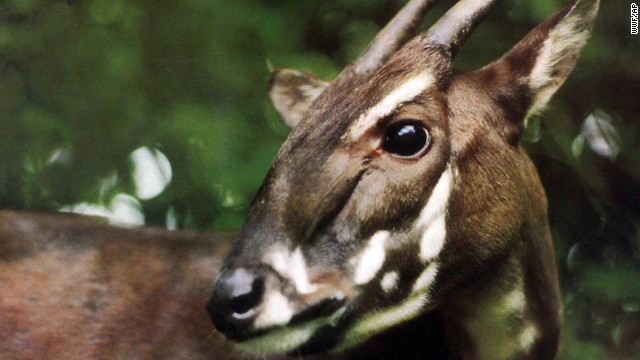 A Saola is caught on camera for the first time in 15 years on September 7 in a forest in Vietnam. The species was discovered in 1992, and at most a few hundred -- and as few as a couple dozen -- of the animals are thought to exist. Because of its rarity and elusiveness, the saola is dubbed the "Asian unicorn." They are recognized by two parallel horns with sharp ends, which can reach 20 inches in length and are found on both males and females.
A Saola is caught on camera for the first time in 15 years on September 7 in a forest in Vietnam. The species was discovered in 1992, and at most a few hundred -- and as few as a couple dozen -- of the animals are thought to exist. Because of its rarity and elusiveness, the saola is dubbed the "Asian unicorn." They are recognized by two parallel horns with sharp ends, which can reach 20 inches in length and are found on both males and females. 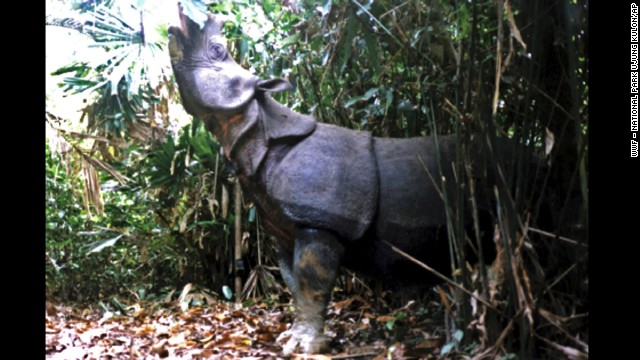 A Javan rhino walks in the national park in the Ujung Kulon National Park in Indonesia. It is one of the most threatened of the five rhino species, with as few as 35 individuals surviving. Their skin has a number of loose folds, giving the appearance of armor plating. The discovery of three dead Javan rhinos in 2010 has intensified efforts to save one of the world's most endangered mammals from extinction.
A Javan rhino walks in the national park in the Ujung Kulon National Park in Indonesia. It is one of the most threatened of the five rhino species, with as few as 35 individuals surviving. Their skin has a number of loose folds, giving the appearance of armor plating. The discovery of three dead Javan rhinos in 2010 has intensified efforts to save one of the world's most endangered mammals from extinction.  The Ganges River dolphin once lived in the Ganges, Brahmaputra, Meghna, Karnaphuli and Sangu rivers of Nepal, India and Bangladesh. But the species is extinct from most of its early distribution ranges. They can only live in freshwater and essentially are blind. They hunt by emitting ultrasonic sounds, which bounce off of fish and other prey, enabling them to "see" an image in their mind.
The Ganges River dolphin once lived in the Ganges, Brahmaputra, Meghna, Karnaphuli and Sangu rivers of Nepal, India and Bangladesh. But the species is extinct from most of its early distribution ranges. They can only live in freshwater and essentially are blind. They hunt by emitting ultrasonic sounds, which bounce off of fish and other prey, enabling them to "see" an image in their mind.  A strutting adult male greater sage-grouse is seen in Alberta, Canada. They were once found across 13 western U.S. states and three Canadian provinces. Because of oil and gas development, conversion of land for agricultural use, climate change and human development, they now only inhibit half their historic range. They are well known for their spectacular mating dances performed on mating grounds called "leks."
A strutting adult male greater sage-grouse is seen in Alberta, Canada. They were once found across 13 western U.S. states and three Canadian provinces. Because of oil and gas development, conversion of land for agricultural use, climate change and human development, they now only inhibit half their historic range. They are well known for their spectacular mating dances performed on mating grounds called "leks." 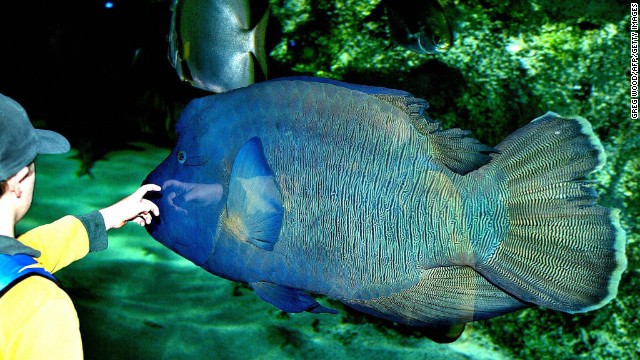 A schoolboy reaches out to touch a humpheaded Maori wrasse as it swims in the world's largest Great Barrier Reef exhibit at the Sydney Aquarium in June 2003. It is an enormous coral reed fish—growing over 6 feet long — with a prominent bulge on its forehead. Some of them live to be over 30 years old. WWF urges local governments in the Coral Triangle to stop the trade and consumption of humphead wrasse, one of the most expensive live reef fishes in the world.
A schoolboy reaches out to touch a humpheaded Maori wrasse as it swims in the world's largest Great Barrier Reef exhibit at the Sydney Aquarium in June 2003. It is an enormous coral reed fish—growing over 6 feet long — with a prominent bulge on its forehead. Some of them live to be over 30 years old. WWF urges local governments in the Coral Triangle to stop the trade and consumption of humphead wrasse, one of the most expensive live reef fishes in the world. 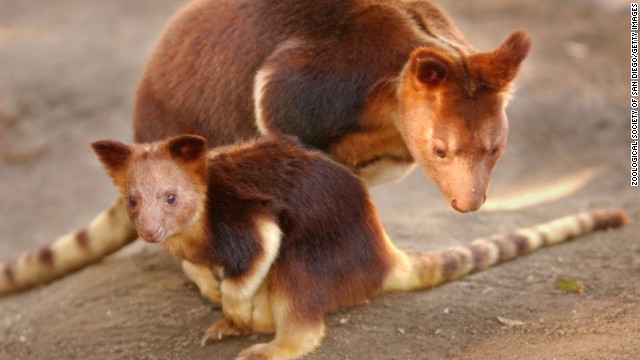 A baby Buergers tree kangaroo appears out of her mother's pouch at the San Diego Zoo in January 2003 in San Diego, California. The endangered species of tree kangaroo is native to the lowland and mountainous rainforests in Papua New Guinea and Indonesia. They have adapted to life in the trees, with shorter legs and stronger forelimbs for climbing, giving them the appearance of a cross between a kangaroo and a lemur. The joey plays a critical role in the Tree Kangaroo Species Survival Plan, a breeding program that has worked to ensure the long-term survivability of the species since 1977.
A baby Buergers tree kangaroo appears out of her mother's pouch at the San Diego Zoo in January 2003 in San Diego, California. The endangered species of tree kangaroo is native to the lowland and mountainous rainforests in Papua New Guinea and Indonesia. They have adapted to life in the trees, with shorter legs and stronger forelimbs for climbing, giving them the appearance of a cross between a kangaroo and a lemur. The joey plays a critical role in the Tree Kangaroo Species Survival Plan, a breeding program that has worked to ensure the long-term survivability of the species since 1977. 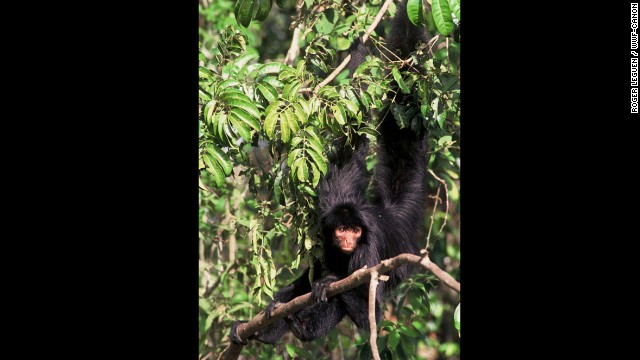 Black spider-monkeys — also known as the Guiana or red-faced spider monkey — are one of the main monkey species encountered in healthy tropical rainforests. It's prehensile tail allows this monkey to find stability when sitting on branches and to reach out for food at the tip of fragile branches by suspending himself.
Black spider-monkeys — also known as the Guiana or red-faced spider monkey — are one of the main monkey species encountered in healthy tropical rainforests. It's prehensile tail allows this monkey to find stability when sitting on branches and to reach out for food at the tip of fragile branches by suspending himself. 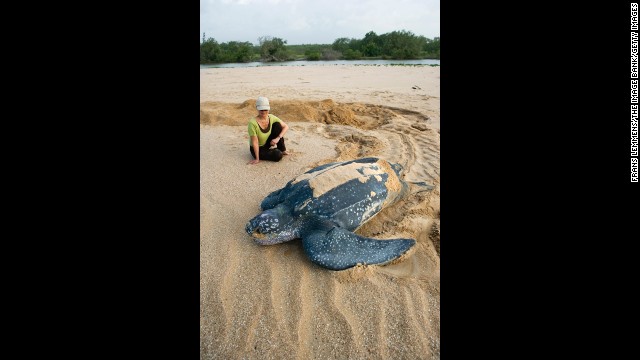 A leatherback turtle goes to sea after burying eggs at the Matapica National Park. They are named for their shell, which is leather-like rather than hard. They are the largest sea turtle species and also one of the most migratory, crossing both the Atlantic and Pacific oceans. Although their distribution is wide, the number of these turtles has seriously declined during the past century as a result of intense egg collection and fisheries bycatch.
A leatherback turtle goes to sea after burying eggs at the Matapica National Park. They are named for their shell, which is leather-like rather than hard. They are the largest sea turtle species and also one of the most migratory, crossing both the Atlantic and Pacific oceans. Although their distribution is wide, the number of these turtles has seriously declined during the past century as a result of intense egg collection and fisheries bycatch. 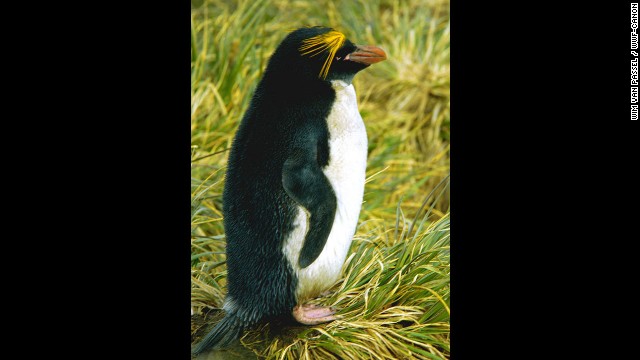 The rockhopper penguin is much smaller in size than the emperor penguin. Rockhopper penguins weigh less than 10 pounds. They were named for their distinctive hopping movements over the rocky hills and cliffs where they live and breed. In the past 30 years, it is estimated that the population of rockhoppers has fallen by nearly 25%, and now climate change could place them at even greater risk.
The rockhopper penguin is much smaller in size than the emperor penguin. Rockhopper penguins weigh less than 10 pounds. They were named for their distinctive hopping movements over the rocky hills and cliffs where they live and breed. In the past 30 years, it is estimated that the population of rockhoppers has fallen by nearly 25%, and now climate change could place them at even greater risk. 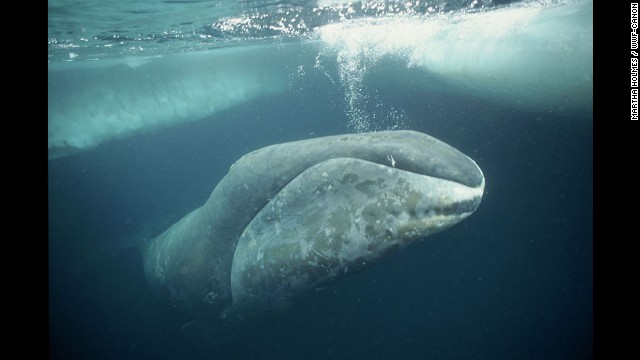 A bowhead whale swims under ice in the Arctic. Adult bowheads are entirely black except for the front part of the lower jaw, which is white and prominently upturned. They can grow up to 60 feet long while still being able to leap entirely out of water. Data show they may be among the longest-living animals on Earth. Based on the recovery of stone harpoon tips in their blubber, and from analysis of eye tissue, scientists believe that the life-span of bowhead whales can be more than 100 years.
A bowhead whale swims under ice in the Arctic. Adult bowheads are entirely black except for the front part of the lower jaw, which is white and prominently upturned. They can grow up to 60 feet long while still being able to leap entirely out of water. Data show they may be among the longest-living animals on Earth. Based on the recovery of stone harpoon tips in their blubber, and from analysis of eye tissue, scientists believe that the life-span of bowhead whales can be more than 100 years. 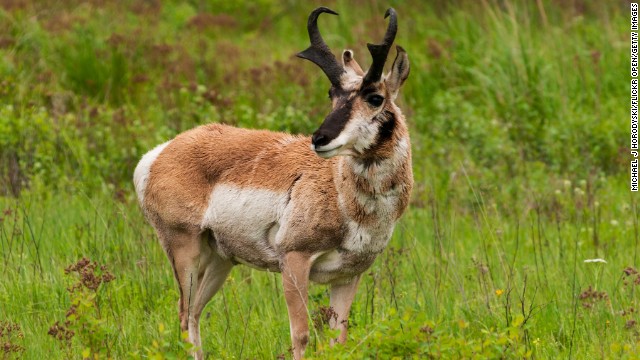 The pronghorn antelope is the fastest hoofed animal in North America and is capable of reaching speeds up to 60 mph. Most pronghorn populations remain stable, but have experienced a historic decline. Pronghorn follow the same migration corridors year after year. Today, the thoroughfares that link the summer breeding grounds and winter grazing areas are being fragmented by roads, cities, fences and energy development. These fragmentations threaten the migratory routes and survival of pronghorn.
The pronghorn antelope is the fastest hoofed animal in North America and is capable of reaching speeds up to 60 mph. Most pronghorn populations remain stable, but have experienced a historic decline. Pronghorn follow the same migration corridors year after year. Today, the thoroughfares that link the summer breeding grounds and winter grazing areas are being fragmented by roads, cities, fences and energy development. These fragmentations threaten the migratory routes and survival of pronghorn. - Saola caught on forest camera in Vietnam
- At most, only a few hundred saola thought to exist
- Species was first discovered in 1992
(CNN) -- Environmentalists in Vietnam were ebullient this week after remote cameras in a forest reserve snapped pictures of a live saola, one of the rarest large mammals on Earth.
At most a few hundred -- and as few as a couple dozen -- of the animals are thought to exist. Because of that rarity and its elusiveness, the saola is dubbed the "Asian unicorn." That moniker comes despite the fact it has two closely spaced parallel horns.
"These are the most important wild animal photographs taken in Asia, and perhaps the world, in at least the past decade," said William Robichaud, coordinator of the Saola Working Group of the International Union for Conservation of Nature's Species Survival Commission, in a World Wildlife Fund press release.
Scientists discover new species in Australian rainforest
"This is an historic moment in Vietnam's efforts to protect our extraordinary biodiversity," Dang Dinh Nguyen, deputy head of the country's Quang Nam Forest Protection Department, said in the release.
The picture of the animal was taken in September in a reserve in the Central Annamite Mountains and announced by the WWF on Tuesday.
441 species discovered in Amazon since 2010
Van Ngoc Thinh, WWF-Vietnam's country director, called the picture "a breath-taking discovery."
"When our team first looked at the photos we couldn't believe our eyes. Saola are the holy grail for Southeast Asian conservationists," Van said in a press release.
The saola, which is a relative of cattle but looks like an antelope, was first discovered in 1992 in forests along the Vietnam-Laos border. A WWF survey team found a skull of the animal in a hunter's home. In Vietnam, a saola was last seen in the wild in 1998. In Laos, a remote camera snapped a picture of one in the wild in 1999. And in 2010, Laotian villagers captured a saola that died before word got to researchers.
Olinguito: The newest rare mammal species
There are no saola in captivity.
Environmentalists said Wednesday the pictures show that efforts to save the saola are working.
"Saola are caught in wire snares set by hunters to catch other animals, such as deer and civets, which are largely destined for the lucrative illegal wildlife trade," Van said in the WWF release. "Since 2011, forest guard patrols ... have removed more than 30,000 snares from this critical saola habitat and destroyed more than 600 illegal hunters' camps."
New legless lizards found in California
'Chewbacca bat,' other bizarre species found in national park







